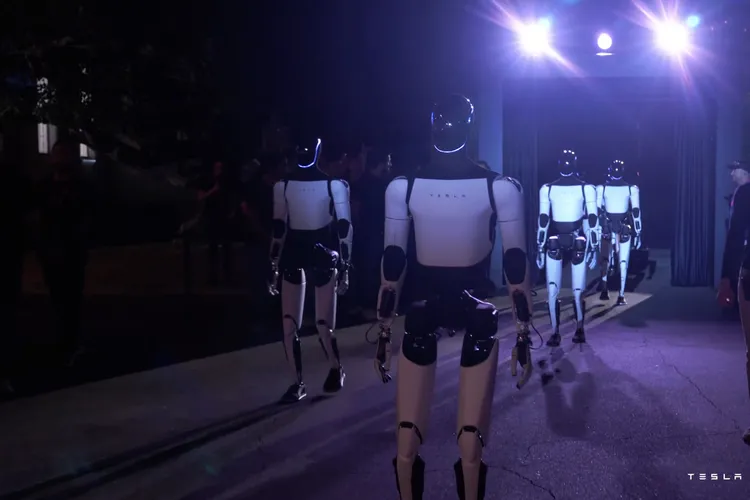Tesla introduces Robotaxi, Robovan, and Optimus at the ‘We Robot’ event

On 10th October, 2024, Tesla hosted the “We, Robot” event, showcasing a bold vision for the future centered around autonomous technology and humanoid robots. And, Honestly this event was really something.
Let’s take a look at the most buzzworthy futuristic innovations from the event.
CyberCab, The Robotaxi:

We all know that Tesla’s vision involves the development of fully autonomous vehicles. And, this time it has come up with the craziest innovation, Cybercab.
We’ll see autonomous cars become 10 times safer than a human.
Musk on autonomous cars at the We Robot Event
- The Cybercab, a robotaxi, is a self-driving vehicle designed to change the way the urban transportation works.
- By eliminating the need for human drivers, Tesla aims to reduce costs, increase efficiency, and improve safety.
- The Cybercab, which is expected to enter production in 2026, features a futuristic design and is equipped with advanced self-driving technology.
- Tesla’s FSD (Full Self-Driving) feature, which is currently available for some Tesla models, requires human oversight.
- However, Musk announced that Teslas with FSD will be able to operate autonomously in California and Texas by next year, marking a significant step towards fully driverless vehicles.
The Robovan, A Versatile Transport Solution:
The Robovan, yet another sleek innovation. A larger autonomous vehicle designed to carry up to 20 passengers or transport goods offers another glimpse into Tesla’s vision for the future.
- The Robovan is sleek and futuristic. It could become a valuable asset in urban areas, providing efficient and sustainable transportation options.
- While Musk did not provide specific details about the Robovan’s production timeline or pricing, the vehicle’s design suggests a focus on comfort, efficiency, and sustainability.
- The Robovan could be particularly useful for transporting large groups of people, such as sports teams or tourists, or for transporting goods in high-density urban areas.
Optimus, A Humanoid Robot for Everyday Tasks:

Tesla revealed Optimus as one of its most ambitious projects at the event. Designed to perform a variety of tasks, the robot is expected to be available for purchase at a relatively affordable price.
- Musk envisions Optimus becoming a versatile companion for everyday life, capable of assisting with household chores, providing companionship, and even serving as a personal assistant.
- While the current prototype is still under development, Musk’s ambitious goals for Optimus suggest a future where humanoid robots play a significant role in our daily lives.
- Optimus could have a wide range of applications, from assisting with tasks in homes and businesses to providing care for the elderly or disabled.
- The robot’s potential to improve our lives is immense, but it is important to note that there are significant technical challenges to overcome before Optimus can become a reality.
The Future of Transportation and Urban Living:
Tesla’s vision could trasform transportation and urban living by reducing traffic congestion, accidents, and emissions, thus improving the quality of life in cities. Additionally, humanoid robots could create new economic opportunities and enhance productivity. However, the full impact of these technologies will depend on factors like adoption rates, regulatory policies, and infrastructure development.
Tesla’s Larger Vision:
Tesla has established itself as a leader in electric vehicles, and its focus on autonomous technology is a natural extension of its commitment to innovation and sustainability. The pursuit of autonomous technology offers significant economic benefits, including new business models and reduced transportation costs. However, challenges such as technical hurdles, regulatory approval, and competition from other companies like Waymo and Cruise remain.
Despite these obstacles, Tesla’s vision is inspiring. The company’s innovative approach and top-tier talent suggest it has the potential to make a significant impact. If Tesla can successfully develop and deploy autonomous vehicles and robots, it could transform transportation, urban living, and the way we interact with technology.
While challenges exist, Tesla’s commitment to innovation positions the company to potentially realize this ambitious vision, leading to a future that is safer, more sustainable, and prosperous for all.

